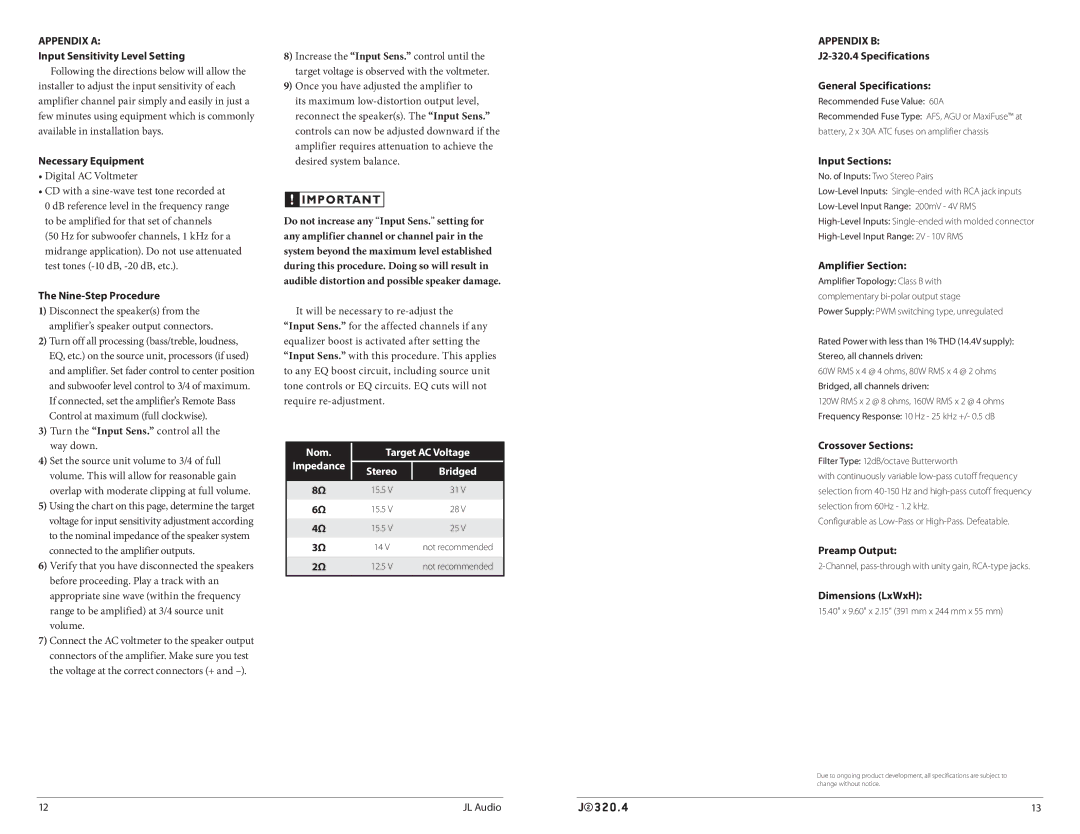
Appendix A:
Input Sensitivity Level Setting Following the directions below will allow the
installer to adjust the input sensitivity of each amplifier channel pair simply and easily in just a few minutes using equipment which is commonly available in installation bays.
Necessary Equipment
•Digital AC Voltmeter
•CD with a
0 dB reference level in the frequency range to be amplified for that set of channels
(50 Hz for subwoofer channels, 1 kHz for a midrange application). Do not use attenuated test tones
The Nine-Step Procedure
1)Disconnect the speaker(s) from the amplifier’s speaker output connectors.
2)Turn off all processing (bass/treble, loudness, EQ, etc.) on the source unit, processors (if used) and amplifier. Set fader control to center position and subwoofer level control to 3/4 of maximum. If connected, set the amplifier’s Remote Bass Control at maximum (full clockwise).
3)Turn the “Input Sens.” control all the way down.
4)Set the source unit volume to 3/4 of full volume. This will allow for reasonable gain overlap with moderate clipping at full volume.
5)Using the chart on this page, determine the target voltage for input sensitivity adjustment according to the nominal impedance of the speaker system connected to the amplifier outputs.
6)Verify that you have disconnected the speakers before proceeding. Play a track with an appropriate sine wave (within the frequency range to be amplified) at 3/4 source unit volume.
7)Connect the AC voltmeter to the speaker output connectors of the amplifier. Make sure you test the voltage at the correct connectors (+ and
8)Increase the “Input Sens.” control until the target voltage is observed with the voltmeter.
9)Once you have adjusted the amplifier to its maximum
Do not increase any “Input Sens.” setting for any amplifier channel or channel pair in the system beyond the maximum level established during this procedure. Doing so will result in audible distortion and possible speaker damage.
It will be necessary to
Nom. | Target AC Voltage | |
Impedance | Stereo | Bridged |
| ||
|
|
|
8Ω | 15.5 V | 31 V |
6Ω | 15.5 V | 28 V |
4Ω | 15.5 V | 25 V |
3Ω | 14 V | not recommended |
2Ω | 12.5 V | not recommended |
|
|
|
Appendix B:
J2-320.4 Specifications
General Specifications:
Recommended Fuse Value: 60A
Recommended Fuse Type: AFS, AGU or MaxiFuse™ at battery, 2 x 30A ATC fuses on amplifier chassis
Input Sections:
No. of Inputs: Two Stereo Pairs
Amplifier Section:
Amplifier Topology: Class B with complementary
Power Supply: PWM switching type, unregulated
Rated Power with less than 1% THD (14.4V supply): Stereo, all channels driven:
60W RMS x 4 @ 4 ohms, 80W RMS x 4 @ 2 ohms Bridged, all channels driven:
120W RMS x 2 @ 8 ohms, 160W RMS x 2 @ 4 ohms Frequency Response: 10 Hz - 25 kHz +/- 0.5 dB
Crossover Sections:
Filter Type: 12dB/octave Butterworth
with continuously variable
Configurable as
Preamp Output:
Dimensions (LxWxH):
15.40" x 9.60" x 2.15" (391 mm x 244 mm x 55 mm)
Due to ongoing product development, all specifications are subject to change without notice.
12 | JL Audio | 13 |
